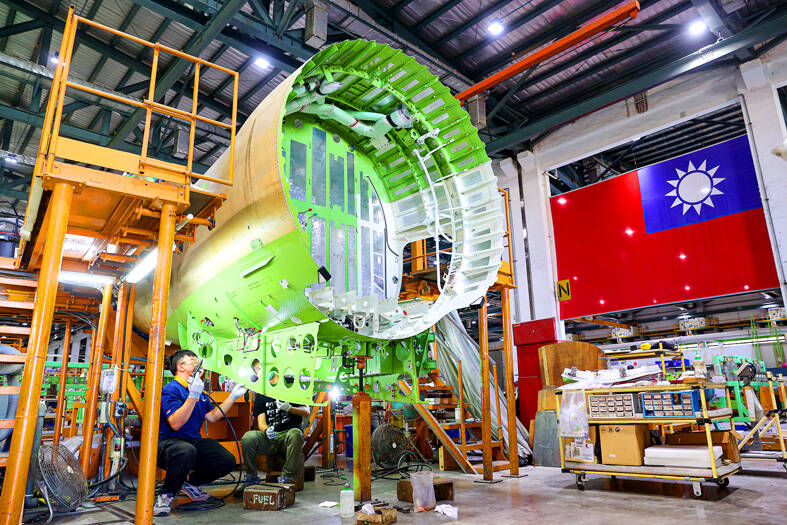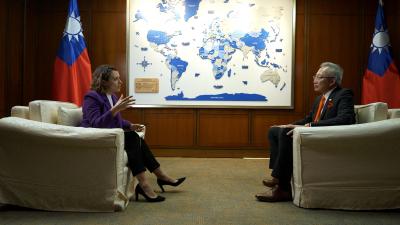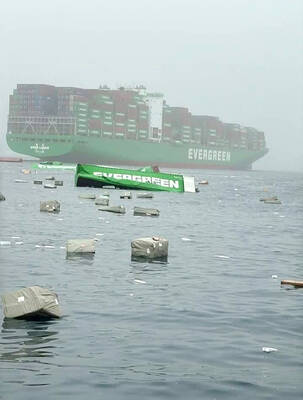The head of Taiwan’s main domestic aircraft developer has called on the government to give the green light and funding to develop next-generation indigenous fighter jets soon, a move local defense experts said could boost the defense industry’s capability and increase leverage when buying advanced fighters from the US.
Ma Wan-june (馬萬鈞), president of the Taichung-based aerospace company Aerospace Industrial Development Corp (AIDC), made the call 30 years after the Indigenous Defense Fighter (IDF) developed by AIDC entered service in the nation’s air force in the 1990s.
Taiwan initiated development of the IDF in May 1982 following the US government’s refusal to sell F-16s to the country.

Photo: CNA
Since beginning service in 1992, the IDF has become the backbone of the nation’s air force fleet.
Following the development of the IDF, AIDC has also been building its own Advanced Trainer Jet (ATJ) dubbed the “Brave Eagle” since 2017, as part of President Tsai Ing-wen’s (蔡英文) plan to build indigenous warplanes, warships and submarines.
The first prototype of the new ATJ, serial number 11001/08-9001, flew for the first time in June 2020. AIDC is scheduled to deliver 66 advanced trainer aircraft by 2026.
“Now is the time for moving on to develop the next-generation ‘Advanced Defense Fighter (ADF),’” Ma said in a media interview on Aug. 18.
While 55 percent of parts used in IDFs and 75 percent of parts used in the ATJ are domestically-made, given Taiwan’s unique diplomatic isolation, AIDC estimated that it would be capable of building 95 percent of all parts to be used in the future ADF once the government agrees to launch the project, Ma said.
Advancing indigenous weapon system development and construction capacities is definitely the right path for Taiwan, since they are valuable for the country both in boosting its defense capability and bringing economic benefits, Ma said.
Indigenous weapon design and development are a long-term mission, and one cannot simply call it off after the completion of one stage, he said.
“It would take approximately 15 years to develop an aircraft, plus another 10 years before entering mass production,” he said.
He disclosed that after completing the development of the IDF from the 1980s to the 1990s, many AIDC talents decided to find work overseas, including in South Korea, where they helped the Asian country develop its T-50 Golden Eagle trainer jets.
“Brain drain is inevitable if a country is not providing a stage for talents to exercise their expertise,” he said.
AIDC, previously known as the Aero Industry Development Center, was founded in 1969 under the Republic of China Air Force. In 1983, it became part of the Chungshan Institute of Science and Technology.
In 1996, AIDC was transformed into a government-owned company under the authority of the Ministry of Economic Affairs.
In response to Ma’s call to develop the next-generation indigenous fighter jet, the Air Force did not give a direct answer, only saying that the military has always made plans for weapons system procurement and development based on its defensive needs and the latest enemy threats.
Meanwhile, former deputy commander of the Air Force, Chang Yan-ting (張延廷), said it was important for Taiwan to start putting resources into developing next-generation fighter jets.
Taiwan was able to buy F-16s from the US in the 1990s after it had successfully developed and produced IDFs, he said, adding that although it is costly, if Taiwan begins to develop its own ADF, the US would more likely grant F-35 sales to the country.

“China is preparing to invade Taiwan,” Deputy Minister of Foreign Affairs Francois Wu (吳志中) said in an exclusive interview with British media channel Sky News for a special report titled, “Is Taiwan ready for a Chinese invasion?” the Ministry of Foreign Affairs said today in a statement. The 25-minute-long special report by Helen Ann-Smith released yesterday saw Sky News travel to Penghu, Taoyuan and Taipei to discuss the possibility of a Chinese invasion and how Taiwan is preparing for an attack. The film observed emergency response drills, interviewed baseball fans at the Taipei Dome on their views of US President

ECONOMIC BENEFITS: The imports from Belize would replace those from Honduras, whose shrimp exports have dropped 67 percent since cutting ties in 2023 Maintaining ties with Taiwan has economic benefits, Ministry of Foreign Affairs officials said yesterday, citing the approval of frozen whiteleg shrimp imports from Belize by the Food and Drug Administration (FDA) as an example. The FDA on Wednesday approved the tariff-free imports from Belize after the whiteleg shrimp passed the Systematic Inspection of Imported Food, which would continue to boost mutual trade, the ministry said. Taiwan’s annual consumption of whiteleg shrimps stands at 30,000 tonnes, far exceeding domestic production, the ministry said. Taiwan used to fill the gap by importing shrimps from Honduras, but purchases slumped after Tegucigalpa severed diplomatic ties with Taiwan

The Executive Yuan yesterday approved a southwestern extension of the Sanying MRT Line from New Taipei to Bade District (八德) in Taoyuan, with a goal of starting construction by late 2026. The 4.03-kilometer extension, featuring three new stations, will run from the current terminus at Yingtao Fude Station (LB12) in New Taipei City to Dannan Station (LB14), where it will connect with Taoyuan’s Green Line, New Taipei City Metro Corp said in a statement. This extension will follow the completion of core Sanying Line, a 14.29-kilometer medium-capacity system linking Tucheng (土城), Sansia (三峽)

CARGO LOSS: About 50 containers at the stern of the ‘Ever Lunar’ cargo ship went overboard, prompting the temporary closure of the port and disrupting operations Evergreen Marine Corp, Taiwan’s largest container shipper, yesterday said that all crew members aboard the Ever Lunar (長月) were safe after dozens of containers fell overboard off the coast of Peru the previous day. The incident occurred at 9:40am on Friday as the Ever Lunar was anchored and waiting to enter the Port of Callao when it suddenly experienced severe rolling, Evergreen said in a statement. The rolling, which caused the containers to fall, might have been caused by factors including a tsunami triggered by an earthquake in Russia, poor winter sea conditions in South America or a sudden influx of waves,